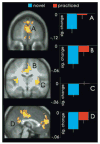Wandering minds: the default network and stimulus-independent thought
- PMID: 17234951
- PMCID: PMC1821121
- DOI: 10.1126/science.1131295
Wandering minds: the default network and stimulus-independent thought
Abstract
Despite evidence pointing to a ubiquitous tendency of human minds to wander, little is known about the neural operations that support this core component of human cognition. Using both thought sampling and brain imaging, the current investigation demonstrated that mind-wandering is associated with activity in a default network of cortical regions that are active when the brain is "at rest." In addition, individuals' reports of the tendency of their minds to wander were correlated with activity in this network.
Figures


Comment in
-
Comment on "Wandering minds: the default network and stimulus-independent thought".Science. 2007 Jul 6;317(5834):43; author reply 43. doi: 10.1126/science.317.5834.43. Science. 2007. PMID: 17615325
References
-
- Singer JL. Daydreaming. Plenum Press; New York: 1966.
-
- Antrobus JS, Singer JL, Greenberg S. Percept Mot Skills. 1966;23:399.
-
- Singer JL, McRaven V. Int J Soc Psychiatry. 1962;8:272. - PubMed
-
- Klinger E. Structure and Functions of Fantasy. New York: Wiley; 1971.
-
- Smallwood J, Schooler JW. Psychol Bull. 2006;132:946. - PubMed
Publication types
MeSH terms
Grants and funding
LinkOut - more resources
Full Text Sources
Other Literature Sources
Medical

